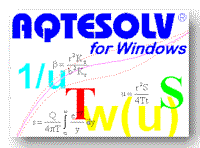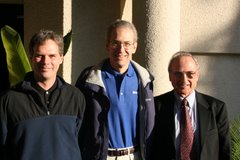| GEMS Research Site (Butler et al. 2000) |
Wednesday, July 20, 2011
Summit in Lawrence, Kansas
On today's date in 1969, Neil Armstrong made history by becoming the first man to walk on the moon. Forty-two years later, July 20th marks another red-letter day with the conclusion of the 1st Lawrence Summit hosted by Jim Butler and attended by Dan Kelleher and myself. The summit met its primary goal of laying the groundwork for future aquifer testing short courses around the world.
Unforgettable moments during the visit included a tour of the venerable Kansas Geological Survey and its GEMS research site, a view of the Allen Field House from Jim's bleacher seats ("Rock, Chalk, Jayhawk!") and a reverential pilgrimage to the James Naismith ("Inventor of Basketball") Memorial. Without question, though, the unsurpassed highlight of the summit was the delightful sushi dinner served to perfection by Jim's daughter, Mai. Many thanks to Jim and wife Yun for their warm hospitality throughout the Lawrence Summit!
Thursday, July 14, 2011
Agarwal Recovery Method
In yesterday's post, I presented three different methods for analyzing recovery tests. Today, I will focus on the Agarwal recovery method which has been used by petroleum engineers for over 30 years. Agarwal (1980) devised a simple yet powerful data transformation for the interpretation of recovery tests. The transformation, known as Agarwal equivalent time, allows one to analyze recovery data with standard type curves developed for drawdown data.
The following figure illustrates the simplicity of the Agarwal method in the analysis of a recovery test. In this example, I matched the familiar Theis type curve, normally applied to drawdown data, to estimate aquifer properties from recovery test data (USBR 1995).
Many different pumping test solutions may be used in conjunction with the Agarwal technique as well as diagnostic methods such as derivative analysis. The figure below shows recovery and derivative data matched together with the Cooper-Jacob straight-line solution.
Recovery test analysis with the Agarwal equivalent-time method is available in AQTESOLV v4.x. This advanced aquifer test analysis software allows you to estimate aquifer properties by matching both recovery and derivative data together.
Learn more about the Agarwal method in Aquifer Testing 101 at the AQTESOLV web site.
The following figure illustrates the simplicity of the Agarwal method in the analysis of a recovery test. In this example, I matched the familiar Theis type curve, normally applied to drawdown data, to estimate aquifer properties from recovery test data (USBR 1995).
 |
| Agarwal recovery analysis using Theis (1935) solution. |
 |
| Agarwal recovery analysis using Cooper-Jacob (1946) solution with derivative. |
Learn more about the Agarwal method in Aquifer Testing 101 at the AQTESOLV web site.
Wednesday, July 13, 2011
Analyzing Recovery Tests
Did you know that AQTESOLV v4.x provides three different methods for the analysis of recovery tests?
The foregoing figures illustrate the use of the three recovery test methods in the analysis of a field example reported in the Ground Water Manual (USBR 1995). The results show that one may obtain consistent aquifer property estimates with all three techniques.
Learn more about the three methods of recovery analysis in Aquifer Testing 101 at the AQTESOLV web site.
 |
| Method 1: Combined analysis of drawdown and recovery data. |
 |
| Method 2: Analysis of residual drawdown data. |
 |
| Method 3: Analysis using Agarwal (1980) method. |
Learn more about the three methods of recovery analysis in Aquifer Testing 101 at the AQTESOLV web site.
Subscribe to:
Posts (Atom)

